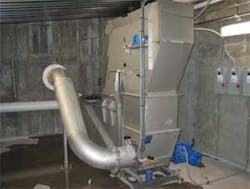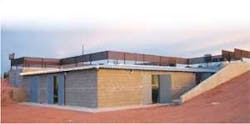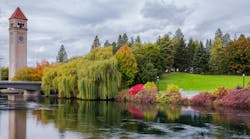When the Tonto Apache Tribe decided to expand its casino operations to include a 101-room hotel, complete with convention space and food service operations located on their 87-acre reservation in Payson, AZ, they needed a technology that would provide reclaimed water suitable for reuse.
They wanted a complete treatment system that would allow for growth; would fit into a relatively small footprint; that could handle the flow variations from the hotel, casino and convention center; and a plant that was easy to operate so they could manage it themselves. Given the shortage of water in the Southwest, they decided to reuse the effluent within the fire suppression system of the hotel, casino and convention center and for local irrigation.
In 2006 the Tribe selected Upflow Sludge Blanket Filtration (USBF™) wastewater treatment technology. Construction commenced later that year and the decentralized plant was completed and commissioned in May 2007. Start-up was planned for later that month but due to other, unrelated issues the plant opening was delayed.
In June 2009 ECOfluid Systems Inc., the company that provided the design as well as the technology and equipment supply, was requested to conduct a detailed start-up review. They found no reason why the plant could not be started and shortly thereafter they commissioned the plant for the second time. It is currently in its initial operation phase.
The plant itself is designed to be simple to operate, using a SCADA system which if required, allows ECOfluid to supervise the plant operations remotely from their office in British Columbia. The facility uses USBF™ technology, followed by microfiltration, sand filtration and UV disinfection, to produce Title 22 or Class A reclaimed water suitable for reuse. The facility is designed to treat 80,000gpd, and is complete with office, lab space and emergency power supply generator.
The raw wastewater is screened by passing through a self contained, inclined fine mechanical screen. The screenings are discharged into a sealed plastic bag and the screened wastewater flows by gravity into an equalization tank. From the equalization tank, wastewater is pumped into a common anoxic compartment which is provided with mixers designed to mix the wastewater with recycled activated sludge from the bottom of the USBF™ filters. From the anoxic compartment the mixed liquor flows to aeration compartments equipped with fine bubble aeration elements.
Aerated, it eventually enters the bottom of the USBF™ filters and, as it rises, upward velocity decreases until the flocs become stationary, thus form a filtering media. As the flocs become large and heavy, they descend to the bottom of the filter and subsequently are transferred back into the anoxic compartment or wasted to the sludge holding tank.
Clarified, treated effluent is collected in a trough on top of the sludge blanket filters before flowing by gravity to an automatic drum-type microfilter having 30 micron openings. The filter operation is controlled by a monitoring level within the drum and when high level is reached the drum rotates and backwash is initiated using reclaimed water from behind the filter.
Once it passes through the microscreen filter the effluent flows by gravity to the filtered effluent tank. It is then pumped through a sand filter and a “pressure” type UV disinfection system into the disinfected effluent tank.
The plant supervision is undemanding. The typical plant operation consists of regular collection and testing of samples, reporting and routine and scheduled equipment inspection and maintenance. All upset conditions and equipment malfunctions are alarmed and annunciated through the SCADA system to designated remote locations and to the operator on call. Limited operator direct input is required.
Because the plant is located close to the entrance of the hotel and casino, it was required to have no visual, odor or noise impact. All equipment and components are installed within a concrete building which was constructed into the side of a hill, making it noise-free and unobtrusive. Aerobic conditions throughout the bioreactors and stabilized sludge dramatically reduce the potential for odor.
To eliminate odors emanating from the screen room, equalization tank and the sludge holding tank, their gas phase is piped to the suction of the air blowers and the gases are subsequently stripped in the bioreactor. Long term operating experience of ECOfluid and others confirms the efficiency of the method with no adverse effects on the blowers. WW





